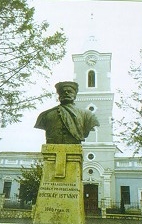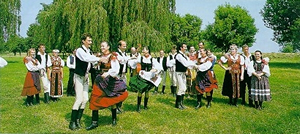
|
 |
|
The bust of Bocskay Istvan |
| |
 |
| Niraj
dance |
|
Miercurea
Nirajului, which
in 2003 became a town, is located on the middle stream
of the Niraj River, at the confluence with the Nirajul
Mic rivulet, 21 km away from Târgu-Mures. The
archaeological vestiges discovered in the area demonstrate
that it has been inhabited ever since the Neolithic.
Stone made hammers were found in Miercurea Nirajului,
dating from 2000-1700 b.Ch. In Laureni, Byzantine coins
were found, dating from emperor Justinianus' time, while
the Roman road, leading to the Calugareni camp, crosses
the border line of the Mosuni and the Beu villages.
The name of the town Szereda comes from the Slavic "sreda",
which means "market place" also has the meaning
of "centre". Documentary evidence dates from
1493. The events that took place between 1600-1603 devastated
the area. General Basta left Transylvania in 1604. In
1605 the Diet of Transylvania was called in Miercurea
Nirajului.
On February 21st 1605,
Bocskay István was elected Prince of Transylvania,
and thus the name of the town entered the annals of
history.
For a long period of time
Miercurea Nirajului had been the administrative center
of Mures district, a place where the community leaders'
assemblies were held. In the XVIIIth century the administrative
center of the district moved to Târgu-Mures. Deprived
of its former glory, Miercurea Nirajului eventually
lost its importance and turned into a rural location.
|
After
the bourgeois revolution of 1848 the place went through
a spectacular development and after 1919, the first factories
and tradesmen's workshops appeared in the area. Between
1970 and 1980 the industry developed, the school system
extended, blocks of flats were built, the House of Culture
was opened. Since the 1989 revolution a significant development
has been taking place, mainly in the private business.
Starting from 1995, many
economic units have been opened, like for instance: a
wood processing factory, a furniture factory, a mill,
a bakery, a meat processing factory etc. Besides the two
kindergartens and the secondary school, there are also
a college and a vocational school as well as the Center
for Horticulture Consulting and the Horticulture School
(long distance education system).
In 1997 the local council
approved the general town planning and in September 2002
a referendum was organized, and as a consequence the place
regained its former status of a city. Documentary evidence
of the included villages: 1332 - Beu , Laureni (Sancto
Laurentio); 1360 - Sardu Nirajului (Saard); 1446 - Mosuni
(Moson); 1484 - Dumitrestii; 1494 - Tâmpa (Thompa)
; 1567 - Veta (Wicke).
Access: District Road DJ
135 Târgu-Mures - Sovata; railway station on the
route Târgu Mures - Sovata (narrow railway, out
of use). |
|
|
|

